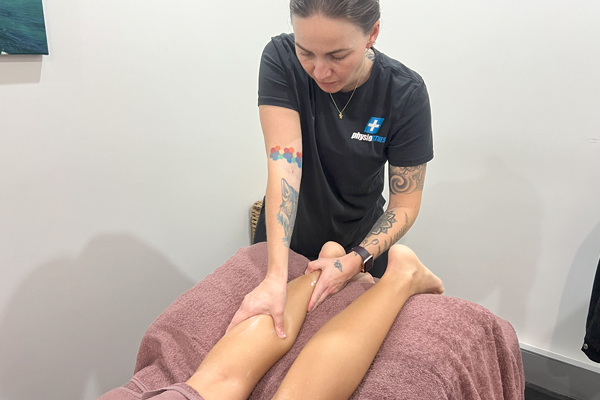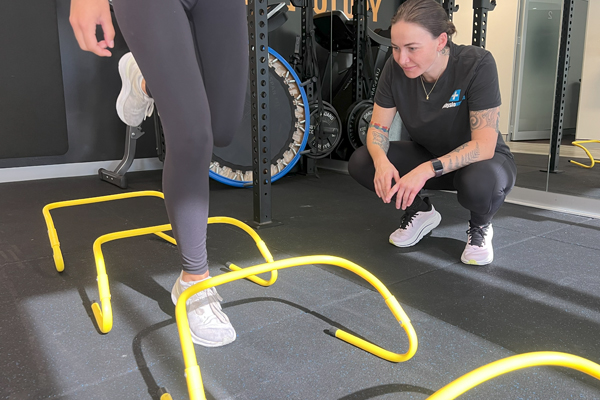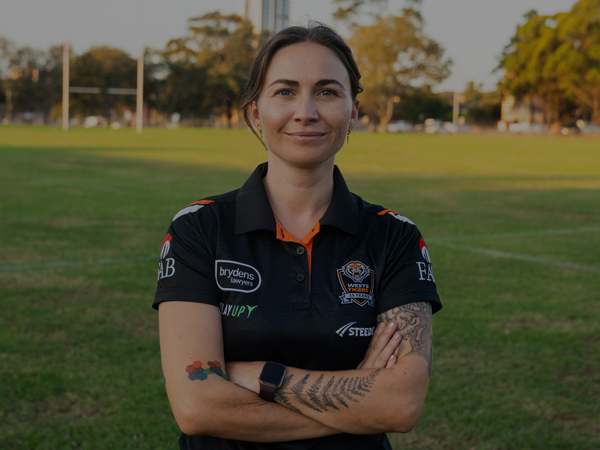
Calf Muscle Tears
Understanding the Injury and Your Recovery
by Krisitn Cameron30 May 2025
Calf tears are one of the most common injuries in sport, especially in activities that involve sudden changes of direction or explosive acceleration and deceleration. These injuries occur when the force placed on the calf muscles exceeds the strength of the muscle fibers.
This can happen suddenly (acutely) or develop over time due to cumulative strain.
Calf tears are often extremely painful and, depending on their severity, may lead to considerable loss of function, swelling, and bruising. As Physiotherapists, we typically classify muscle tears into three grades:
Grade 1: Microtears within the muscle fibres
Grade 2: Partial thickness muscle tear
Grade 3: Full thickness muscle tear
These classifications help guide expectations for recovery timelines. However, it’s important to understand that severity can vary even within these grades, and numerous external factors—such as age, fitness level, and treatment adherence—can influence healing times.
Why Rehabilitation Matters
A structured and progressive rehabilitation program is essential before returning to sport. Following a tear, the muscle tends to weaken (atrophy), increasing the risk of re-injury. Additionally, imbalances during recovery can place excess strain on adjacent structures, particularly the Achilles tendon, potentially leading to tendinitis or tendinosis.
A well-designed rehab plan introduces the right amount of load at the right time to stimulate healing and restore strength. Below is an example of what your rehabilitation journey may look like.

1. Acute Phase (0–7 Days)
Goals:
• Protect the muscle from further damage
• Reduce swelling and restore pain-free range of motion
Management:
• Limit walking; crutches may be helpful in the early days
• Use Tubigrip compression to control swelling
• Ice for pain relief as needed
• Avoid stretching the muscle
• Physio treatment may include: light effleurage, gentle soft tissue release, passive range of motion, K-taping
Suggested Exercises:
• Gentle ankle dorsiflexion/plantarflexion within pain-free range
• Begin isometric contractions (e.g., gentle calf push against a wall)

2. Recovery Phase (1–6 to 12 Weeks)
Duration depends on severity of the tear
Goals:
• Promote tissue healing
• Restore strength and power
• Gradually return to running and sport
Management:
• Gradually increase walking distance as tolerated
• Continue to avoid stretching in the early part of this phase
• Physio Treatment may include: Soft tissue release, dry needling, passive stretching, K-taping
Exercise Progression:
Early Recovery:
• Progress from wall isometrics to static isometric holds
• Begin resistance band exercises
Mid Recovery:
• Introduce loaded exercises (calf raises):
- Start with double-leg raises
- Progress to eccentric loading
- Then move to single-leg variations
• Add balance exercises using progressively unstable surfaces
Late Recovery:
• Continue calf raise variations
• Include explosive movements (e.g., hopping, jumping and landing drills)
• Return to running
• Begin sport-specific drills

3. Maintenance Phase (6–12+ Weeks)
Goals:
• Maintain calf muscle strength and resilience
• Prevent recurrence
• Return to full sport participation
Ongoing Exercises:
• Integrate calf strengthening into your regular workout routine
• Continue sport-specific lower limb exercises to enhance neuromuscular control
The Importance of Timing
It’s crucial to work closely with your physiotherapist throughout recovery. Advancing through the phases too quickly can increase your risk of reinjury and delay your return to sport. Each phase must be tailored to your individual progress, not just the calendar.
Prevention is Key
While calf tears rarely cause long-term issues, they can be painful and require weeks of rehabilitation. That’s why prevention is always the best strategy. By regularly incorporating calf strengthening and lower limb, sport-specific exercises into your training, you can increase your body’s capacity to handle high loads and better protect itself in vulnerable situations.
Staying proactive with your muscle health can significantly reduce the risk of calf injuries—and keep you doing what you love without interruption.

Calf tears are often extremely painful and, depending on their severity, may lead to considerable loss of function, swelling, and bruising. As Physiotherapists, we typically classify muscle tears into three grades:
Grade 1: Microtears within the muscle fibres
Grade 2: Partial thickness muscle tear
Grade 3: Full thickness muscle tear
These classifications help guide expectations for recovery timelines. However, it’s important to understand that severity can vary even within these grades, and numerous external factors—such as age, fitness level, and treatment adherence—can influence healing times.
Why Rehabilitation Matters
A structured and progressive rehabilitation program is essential before returning to sport. Following a tear, the muscle tends to weaken (atrophy), increasing the risk of re-injury. Additionally, imbalances during recovery can place excess strain on adjacent structures, particularly the Achilles tendon, potentially leading to tendinitis or tendinosis.
A well-designed rehab plan introduces the right amount of load at the right time to stimulate healing and restore strength. Below is an example of what your rehabilitation journey may look like.

1. Acute Phase (0–7 Days)
Goals:
• Protect the muscle from further damage
• Reduce swelling and restore pain-free range of motion
Management:
• Limit walking; crutches may be helpful in the early days
• Use Tubigrip compression to control swelling
• Ice for pain relief as needed
• Avoid stretching the muscle
• Physio treatment may include: light effleurage, gentle soft tissue release, passive range of motion, K-taping
Suggested Exercises:
• Gentle ankle dorsiflexion/plantarflexion within pain-free range
• Begin isometric contractions (e.g., gentle calf push against a wall)

2. Recovery Phase (1–6 to 12 Weeks)
Duration depends on severity of the tear
Goals:
• Promote tissue healing
• Restore strength and power
• Gradually return to running and sport
Management:
• Gradually increase walking distance as tolerated
• Continue to avoid stretching in the early part of this phase
• Physio Treatment may include: Soft tissue release, dry needling, passive stretching, K-taping
Exercise Progression:
Early Recovery:
• Progress from wall isometrics to static isometric holds
• Begin resistance band exercises
Mid Recovery:
• Introduce loaded exercises (calf raises):
- Start with double-leg raises
- Progress to eccentric loading
- Then move to single-leg variations
• Add balance exercises using progressively unstable surfaces
Late Recovery:
• Continue calf raise variations
• Include explosive movements (e.g., hopping, jumping and landing drills)
• Return to running
• Begin sport-specific drills

3. Maintenance Phase (6–12+ Weeks)
Goals:
• Maintain calf muscle strength and resilience
• Prevent recurrence
• Return to full sport participation
Ongoing Exercises:
• Integrate calf strengthening into your regular workout routine
• Continue sport-specific lower limb exercises to enhance neuromuscular control
The Importance of Timing
It’s crucial to work closely with your physiotherapist throughout recovery. Advancing through the phases too quickly can increase your risk of reinjury and delay your return to sport. Each phase must be tailored to your individual progress, not just the calendar.
Prevention is Key
While calf tears rarely cause long-term issues, they can be painful and require weeks of rehabilitation. That’s why prevention is always the best strategy. By regularly incorporating calf strengthening and lower limb, sport-specific exercises into your training, you can increase your body’s capacity to handle high loads and better protect itself in vulnerable situations.
Staying proactive with your muscle health can significantly reduce the risk of calf injuries—and keep you doing what you love without interruption.

B.Phty (Cred), APAM
Senior Physiotherapist
Senior Physiotherapist



